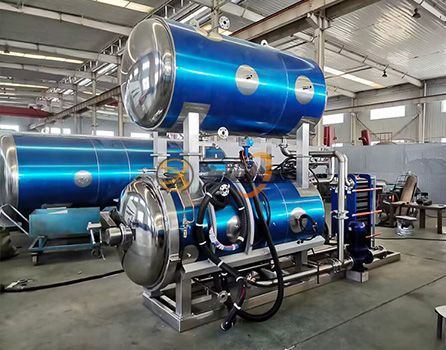When it comes to ensuring food safety and extending shelf life without compromising quality, the retort machine has proven to be a true game-changer. Whether you're a food manufacturer scaling up production or a startup looking to enter the ready-to-eat market, understanding how a retort machine works—and why it matters—can help you make smarter business decisions.

What Is a Retort Machine?
At its core, a retort machine is a thermal processing system used to sterilize food products after they’ve been packaged. Unlike traditional cooking or boiling, retort technology uses high-pressure steam, hot water spray, or a steam-air mixture to raise the temperature inside sealed containers—like pouches, cans, or jars—to kill bacteria and pathogens.
This process not only ensures safety but also maintains the taste, texture, and nutritional value of food products, making it ideal for soups, sauces, pet food, dairy items, and more.
Why Food Businesses Rely on Retort Machines
Here’s why the retort machine has become a staple in food production facilities worldwide:
Extended Shelf Life Without Preservatives
Products can last 6 to 24 months at room temperature with no need for refrigeration.Preserves Natural Flavor and Nutrition
Controlled heat penetration ensures minimal nutrient loss and maximum flavor retention.Packaging Flexibility
Compatible with cans, glass jars, flexible pouches, trays, and cartons.Automation and Precision
Digital controls enable exact time, temperature, and pressure adjustments—ensuring consistent quality every cycle.Compliance with Global Standards
Most industrial retort machines meet CE, FDA, HACCP, and ISO certifications.
Types of Retort Machines
There are different types of process retorts—each designed to handle specific food types, packaging formats, and production needs:
| Type | Description | Best For |
|---|---|---|
| Steam Retort | Uses saturated steam to sterilize food in sealed containers. No air is present during the process. | Canned foods, metal containers, rigid packaging |
| Water Spray Retort | Sprays hot water over the product while circulating steam or water for uniform heating. | Glass jars, plastic containers, pouches |
| Steam-Air Retort | Combines steam and compressed air with forced circulation for even temperature distribution. | Flexible packaging, large-size products |
| Rotary Retort | Rotates products during sterilization to improve heat penetration and preserve texture. | Viscous food, sauces, baby food in pouches or cans |
Real-World Applications
Retort technology is widely used across industries:
Ready Meals – Curries, soups, stews, pasta sauces
Baby Food – Pureed fruits and vegetables
Pet Food – Wet canned and pouch products
Dairy Products – Milk-based desserts, custards
Medical Nutrition – Liquid diets, therapeutic meals
Beverages – Plant-based drinks, juices, herbal teas
Choosing the Right Retort Machine
Before investing in a retort system, ask yourself:
What is my production volume?
What kind of packaging do I use?
Are my products low-acid or high-acid?
Do I need batch or continuous processing?
What level of automation suits my workforce?
Consulting with a reliable manufacturer like Lonkia can help you tailor a solution that fits your current operations and future growth.
FAQ: Retort Machine Basics
Q1: What is the temperature range used in a retort machine?
Most retort machines operate between 115°C to 135°C (239°F to 275°F), depending on the food type and packaging.
Q2: Can I use a retort machine for both solid and liquid products?
Yes. Retort machines are highly adaptable and can process a wide variety of food textures and consistencies.
Q3: How long does the retort process take?
Cycle time ranges from 20 to 90 minutes, influenced by product size, density, and type of retort used.
Q4: Is a retort machine suitable for small businesses?
Absolutely. Compact models with semi-automatic features are available, perfect for startups and small-batch producers.
Q5: What's the difference between pasteurization and sterilization in retort machines?
Pasteurization heats food to around 85°C–100°C, killing most bacteria, suitable for short shelf-life. Sterilization in retort machines goes above 121°C to destroy all harmful microorganisms, extending shelf life significantly.
Whether you're producing gourmet meals or pet nutrition, investing in a retort machine allows you to stay competitive while meeting global food safety standards. With benefits like longer shelf life, reduced waste, and flexible packaging compatibility, it’s no surprise that retort technology is leading the future of food processing.
Interested in exploring a solution for your business? Browse our full range of retort machines here →

